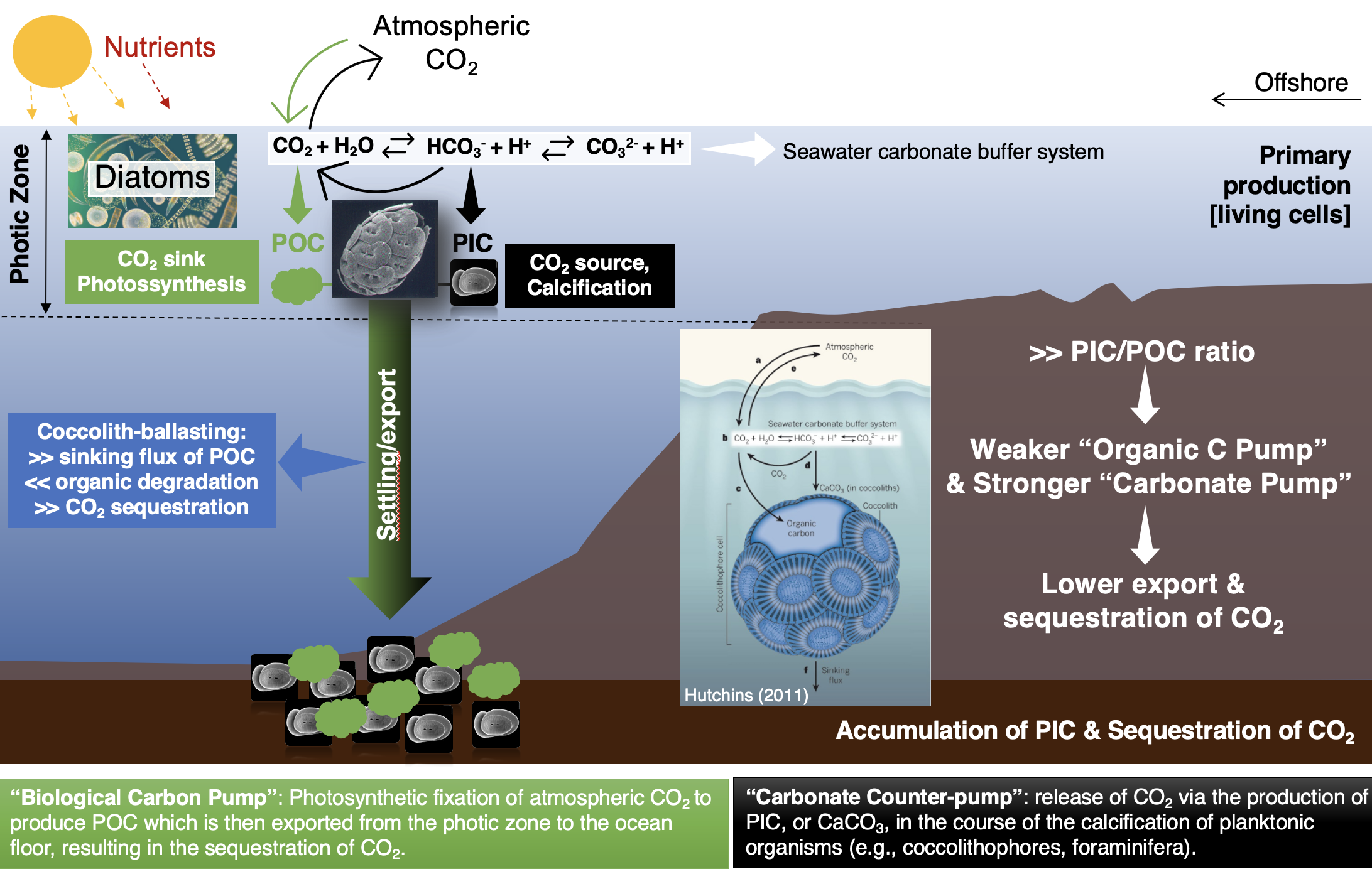Marine phytoplankton are responsible for about half of the global primary production, taking care of oxygen production and the main responsible for the “biological carbon pump” (i.e., biologically meditated fixation of carbon dioxide, CO2. to produce particulate organic carbon, POC, and its export and sequestration to the deep ocean) [1].
Like land plants, marine phytoplankton they need light and nutrients to survive and reproduce in the photic zone of the ocean. Ongoing climate warming, however, is likely to hamper their productivity and change their community structure, by reducing the supply of nutrients from deep waters to the euphotic zone due to enhanced ocean stratification. This has cascading effects not only for the remaining marine food web, but also for the regulation of atmospheric CO2 via the “biological carbon pump”.
Being at the same time photosynthetic and calcifying, coccolithophores (calcifying phytoplankton) play a particularly unique role in marine biogeochemical cycles, being major contributors to the “rain ratio” (PIC/POC) [2], a key parameter for biogeochemical models exploring the long-term efficiency of CO2 drawdown. Thereby, any changes in their productivity and species composition are almost certainly going to change the earth’s climate.
Why are coccolithophores so biogeochemically important for the climate? Well, coccolithophores influence and interact with the marine carbon cycle in three main ways. First, being primary producers, they act as sinks of atmospheric CO2 while doing photosynthesis to produce particulate organic carbon (POC). Second, they also act as sources of CO2 while doing calcification to produce particulate inorganic carbon (PIC). Thirdly, they also act as dense mineral ballast to facilitate the transport of carbon-enriched organic material from the surface down to the deep ocean and thereby, improving its chances to get sequestered in the deep ocean. In others words, coccolithophores actively contribute to the functioning of the “biological carbon pump”, through which CO2 is reduced from the atmosphere, but also of the “carbonate counter-pump”, through which CO2 is released back to the atmosphere. To this biogenic PIC/POC ratio we call the rain ratio, and this is largely what mediates the flux of CO2 between the ocean and the overlying atmosphere. The higher is the PIC/POC ratio, the weaker will be the capacity of the “biological carbon pump” to capture CO2 from the atmosphere and to sequester it down to the deep ocean.
In our new paper published in Limnology & Oceanography, we explore the role of coccolithophores in the export production of total carbonate fluxes across between NW Africa and the Caribbean, right underneath the largest dust plume originating from Africa.
In this study, we provide new evidence suggesting that the increasing production of carbonate by deep-dwelling coccolithophore species in response to ocean warming is likely to weaken the “biological carbon pump” through rising the “rain ratio” and reducing the coccolith-ballasting efficiency. However, increasing Saharan dust outbreaks across the tropical North Atlantic may contribute to counterbalance this tendency, either by fertilizing fast-blooming coccolithophore species (as well as of other phytoplankton groups) and/or by stimulating the export of organic carbon via both dust- and coccolith-ballasting.
Here, you can see the spatiotemporal variation of (a) UPZspp/LPZspp ratio (light green) in coccolith fluxes of E. huxleyi and G. oceanica typical of the upper photic zone (UPZ), and F. profunda and G. flabellatus typical of the lower photic zone (LPZ) (used as a proxy for nutricline depth dynamics; Guerreiro et al. 2017, Guerreiro et al., 2019), and surface chlorophyll a concentrations (Chl a, black line); (b) total fluxes of POC (green) and bSiO2/CaCO3 molar ratio (orange line) as a proxy for the ratio of silicifying to calcifying plankton [1], (c) rain ratio (CaCO3/POC, in blue) and Coccolith-CaCO3/POC molar ratios (black line); (d) relative contribution of coccolith-CaCO3 to total CaCO3 fluxes by the most important carbonate producing coccolith taxa; (e) total coccolith-CaCO3 fluxes (blue) and surface ocean concentrations of particulate inorganic carbon (PIC) (black line); and (f) fluxes of (from bottom to the top) CaCO3, organic matter, biogenic silica, and lithogenic dust (M1, M2, and M4 data from Korte et al. 2017 and van der Does et al. 2020).
Our new insights, hence, suggest that any climate-driven changes – both oceanographic and atmospheric - in the composition and distribution of coccolithophore communities are likely to impact the cycling and sequestration of carbon at both regional and global scales. This highlights the need of addressing the role of this important phytoplankton group in modulating the “rain ratio”, to more accurately project the functioning of the “biological carbon pump” in an ever-warming ocean.
Click here to know more about these issues!
References:
[1] Cermeño, P., Dutkiewicz, S., Harris, R.P., Follows, M., Schofield, O., Falkowski, P.G., 2008. The role of nutricline depth in regulating the ocean carbon cycle. PNAS 105 (51), 20344–20349. https://doi.org/10.1073/pnas.0811302106.
[2] Rost, B., Riebesell, U., 2004. Coccolithophores and the biological pump: responses to environmental changes. In: Coccolithophores from molecular processes to global impact. Hans R. Thierstein; Jeremy R. Young (Eds.) Berlin, Springer, 99-125.3. IPCC, 2019).

![Here, you can see the spatiotemporal variation of (a) UPZspp/LPZspp ratio (light green) in coccolith fluxes of E. huxleyi and G. oceanica typical of the upper photic zone (UPZ), and F. profunda and G. flabellatus typical of the lower photic zone (LPZ) (used as a proxy for nutricline depth dynamics; Guerreiro et al. 2017, Guerreiro et al., 2019), and surface chlorophyll a concentrations (Chl a, black line); (b) total fluxes of POC (green) and bSiO2/CaCO3 molar ratio (orange line) as a proxy for the ratio of silicifying to calcifying plankton [1], (c) rain ratio (CaCO3/POC, in blue) and Coccolith-CaCO3/POC molar ratios (black line); (d) relative contribution of coccolith-CaCO3 to total CaCO3 fluxes by the most important carbonate producing coccolith taxa; (e) total coccolith-CaCO3 fluxes (blue) and surface ocean concentrations of particulate inorganic carbon (PIC) (black line); and (f) fluxes of (from bottom to the top) CaCO3, organic matter, biogenic silica, and lithogenic dust (M1, M2, and M4 data from Korte et al. 2017 and van der Does et al. 2020). ](https://images.squarespace-cdn.com/content/v1/5ff300efceaa345b8ff2d01f/1624297206614-NTZWBK2VND5M3NUVYRZY/Figure+6_Guerreiro+et+al.jpg)